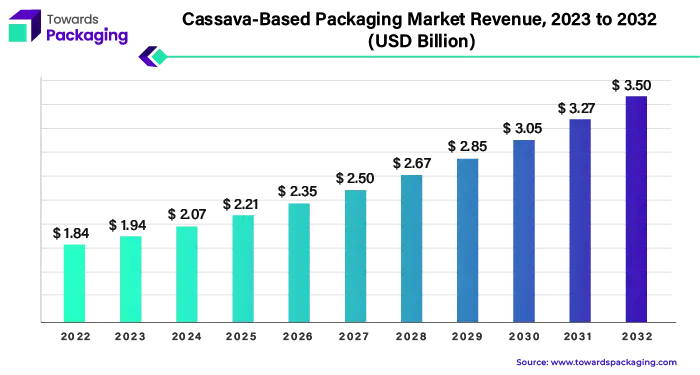Global Cassava-Based Packaging Market Growth Outlook (2023–2032)
The global market for cassava-based packaging is projected to expand significantly, rising from $1.84 billion in 2022 to approximately $3.50 billion by 2032. This growth represents a compound annual growth rate (CAGR) of 6.7% over the forecast period.

Download Statistical Data: https://www.towardspackaging.com/download-statistics/5180
Cassava-Based Packaging Market: Key Insights and Trends
Market Highlights
The global cassava-based packaging market is on a growth trajectory, starting at $1.84 billion in 2022 and projected to reach $3.50 billion by 2032, with a steady CAGR of 6.7%. Key growth drivers include:
- European innovation in cassava-based packaging solutions.
- Rising demand in North America due to eco-conscious consumer trends.
- The introduction of cassava cups as a sustainable alternative in packaging.
- Increased use of cassava starch for food packaging applications.
- The role of retail stores in promoting cassava-based packaging across industries.
Summary
Cassava-based packaging is emerging as a sustainable alternative to traditional plastics, driven by changing consumer preferences and the growing demand for eco-friendly options. Products such as cups, bowls, and plates made from cassava provide environmentally friendly solutions for various industries, including food and beverage, cosmetics, and pharmaceuticals. These products are lightweight, biodegradable, and offer protection against contamination, making them ideal for modern fast-paced lifestyles.
The market’s growth is influenced by:
- Government regulations banning non-biodegradable materials, especially in Europe and North America.
- Consumer awareness about sustainability and environmental impact.
- Technological innovations by leading companies to create durable and versatile cassava-based products.
Advantages and Challenges
Cassava-based packaging is well-suited for hot and cold foods, microwave-safe, and biodegradable, making it a popular choice in the food service industry. However, high initial production costs and limited scalability can pose challenges. Government incentives and increasing consumer demand are expected to address these issues, creating opportunities for new entrants.
Impact of COVID-19
The pandemic accelerated demand for sustainable and health-conscious packaging solutions, benefitting the cassava-based packaging market. However, disruptions in raw material supply chains temporarily slowed production. Recovery efforts and regulatory support have since fueled growth in this sector.
Market Trends
- Sustainability and Biodegradability: Cassava-based packaging offers an eco-friendly alternative to plastic, reducing dependence on fossil fuels.
- Bio-Based Innovations: Cassava starch is being used to develop compostable, renewable, and biodegradable materials for packaging.
- Versatility: Cassava-based materials are adaptable for various products, including films, trays, bags, and containers.
- Consumer Awareness: Increasing environmental consciousness among consumers drives demand for natural and sustainable packaging solutions.
Example Development:
In February 2022, Cassava Bags Australia launched the world’s first degradable single-use bags and liner products, highlighting the market’s innovative potential.
Cassava-based packaging is poised for robust growth as businesses and consumers prioritize sustainability, making it a transformative force in the global packaging industry.
Buy Premium Global Insight: https://www.towardspackaging.com/price/5180
Get the latest insights on packaging industry segmentation with our Annual Membership – https://www.towardspackaging.com/get-an-annual-membership
If you have any questions, please feel free to contact us at sales@towardspackaging.com
Browse our Brand-New Journal:
https://www.towardshealthcare.com
https://www.towardsautomotive.com
For Latest Update Follow Us: https://www.linkedin.com/company/towards-packaging/
Get Our Freshly Printed Chronicle: https://www.packagingwebwire.com/